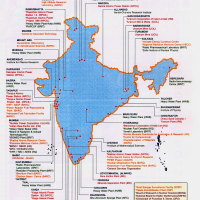Instead of waiting till the investigation makes substantial progress, the police and the agencies, with the help of sensation-hungry media, have already started pointing the finger at the Muslim community, the Indian Mujahideen and Pakistan.
If there is terror, it has to be a Muslim. If he is a Muslim, he has to be from the IM. If it is the IM, it must have acted at the instance of Pakistan’s Inter-Services Intelligence (ISI). That seems to be the thinking reflex of the police and the agencies.
In October last, according to the Delhi Police, a Muslim suspect belonging to the IM told them during his interrogation that the IM had recced the Dilsukhnagar area as a possible target. From this, one could have reasonable suspicion that the IM might have carried out the attack. To strengthen the suspicion, one must have additional evidence which has not been forthcoming till now. Despite this, the police and the agencies in their mind have already turned the suspicion into certainty. Almost the entire investigation is now focused on the IM, overlooking other possibilities.
One cannot think of a more unprofessional way of dealing with terrorism. Very often, our initial hasty conclusions remain unproved or uncorroborated. That is why the investigation of so many of our terrorism cases has reached a dead end. Many of the cases remain undetected or unprosecuted or unsuccessful even if prosecuted.
After every few months, we are taken by surprise by a new act of terrorism because we didn’t investigate professionally the previous acts of terrorism. Our track record has been one of hurtling from one hasty conclusion to another.
Instead of learning lessons from the past, we continue repeating the same mistakes. Imprecise intelligence, alerts not followed up by ground action to strengthen physical security, lack of beat patrolling by the police despite our talking about it for years, absence of professional reconstruction of an act of terrorism to determine how the terrorists managed to succeed, cover-up of the sins of commission and omission of our police and agencies–that has been our track record. Unless we get out of this unprofessional rut, terrorists will continue to strike with impunity and innocent civilians will continue to die.
B. Raman is Additional Secretary (Retd), Cabinet Secretariat, Govt of India, New Delhi, and, presently, Director, Institute For Topical Studies, Chennai, and Associate of the Chennai Centre For China Studies


 Credit: Jessica Hinves
Credit: Jessica Hinves








